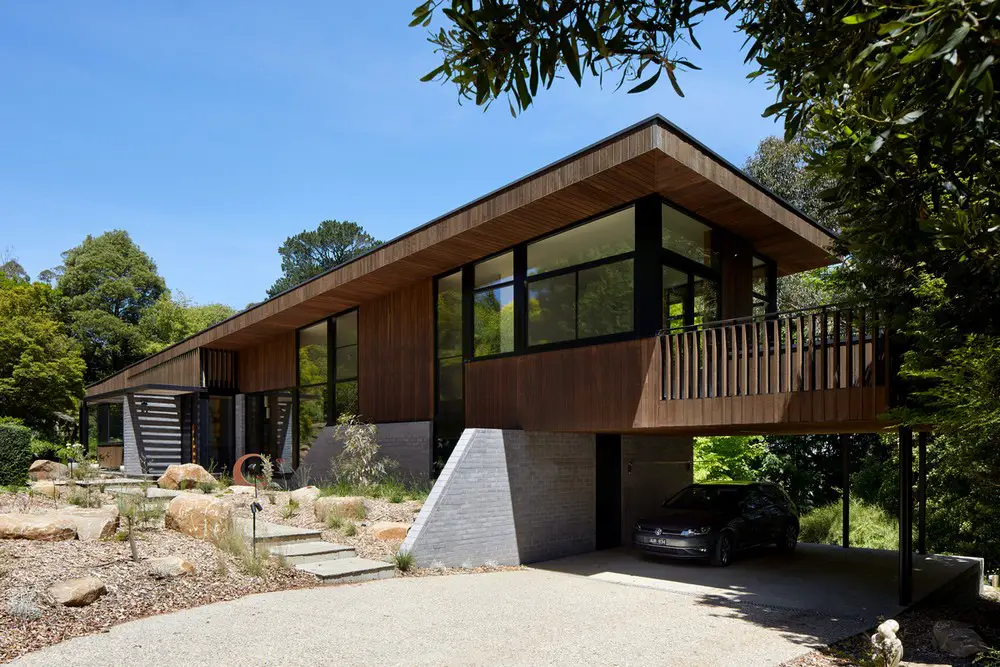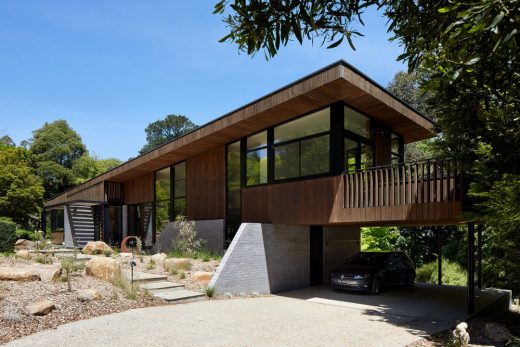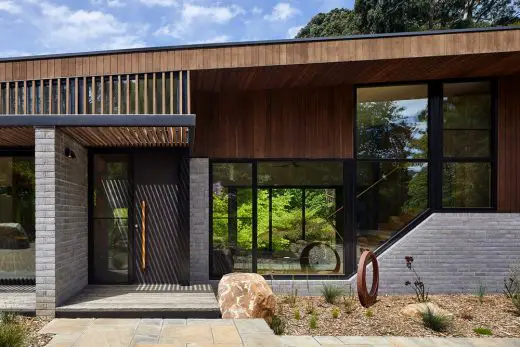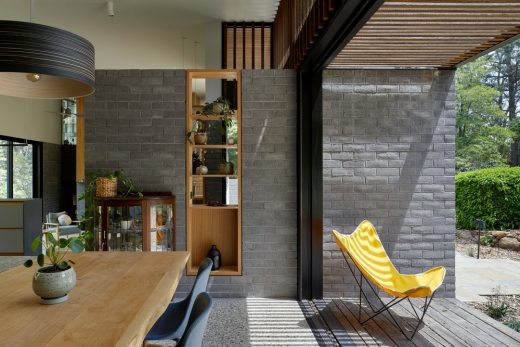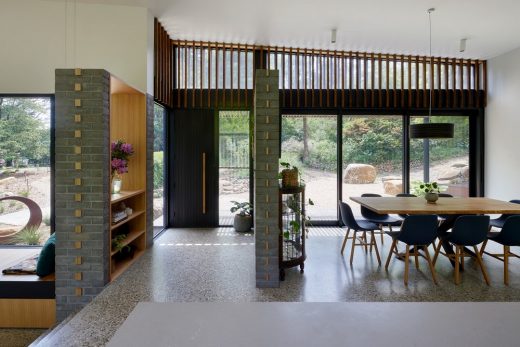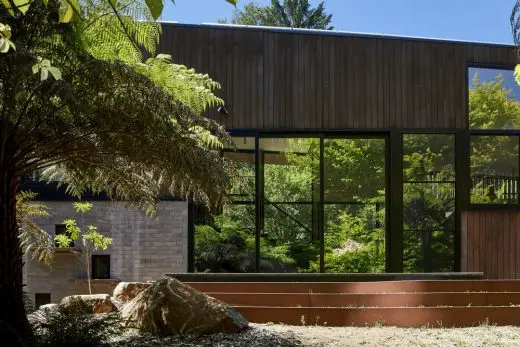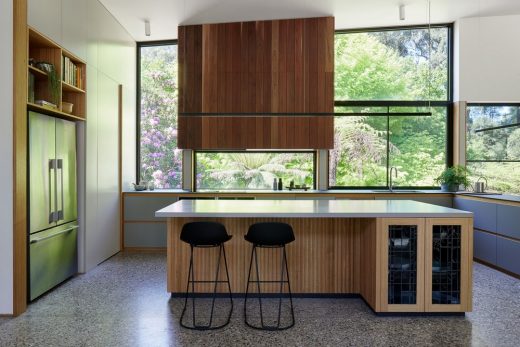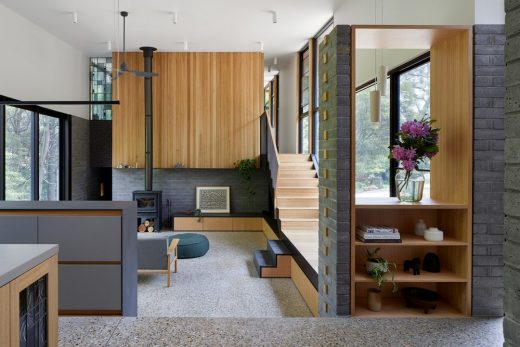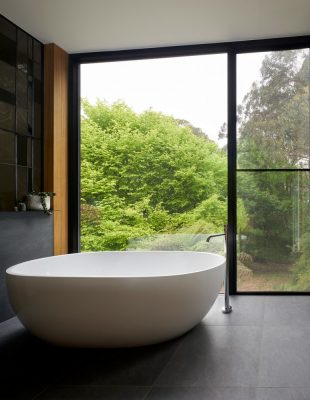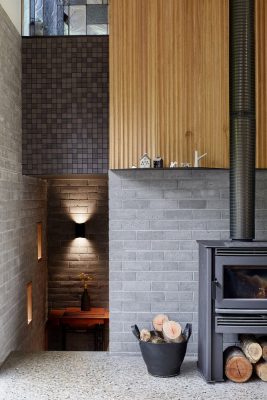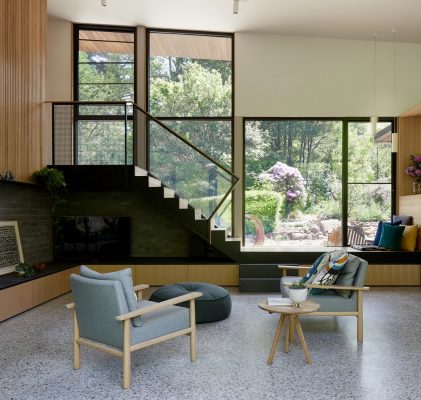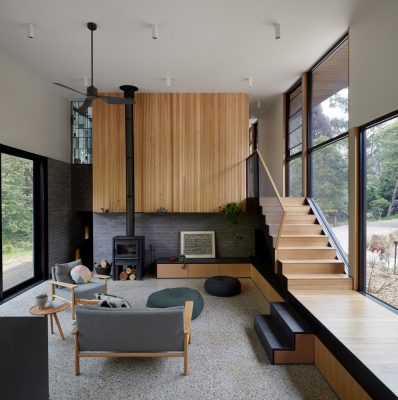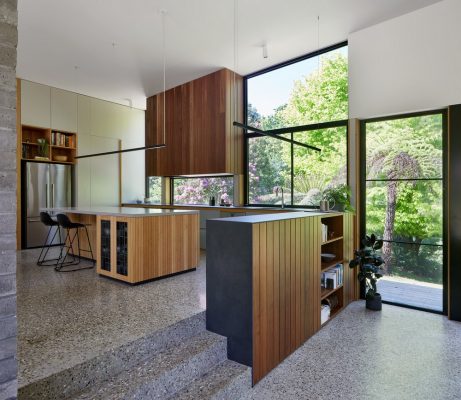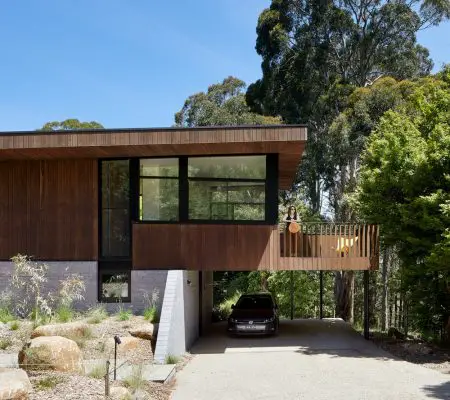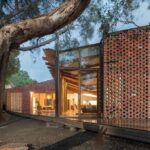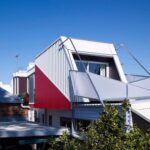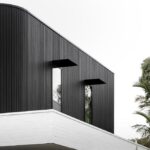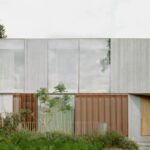Olinda House in Melbourne, Victoria Building, Melbourne Real Estate Project, Architecture Images
Olinda House in Melbourne
23 Feb 2020
Olinda House
Architects: BENT Architecture
Location: Melbourne, Victoria, Australia
Olinda House is the result of a love story between the owners and their site. Designed for vets and keen gardeners, Matt and Leanne, the home brings the outdoors in and means their daily lives are immersed in greenery. We worked with Matt on his previous house, so when the couple decided on a tree change in the stunning Dandenong Ranges, they asked us to design a home to embrace the landscape with a focus on sustainability.
The leafy surrounds means the site has a moderate bushfire risk with a BAL-29 rating. In order to meet these building regulations and keep the home safe from bushfire, the design and material selection was an important consideration. To help achieve this rating, the home is built on a solid podium of concrete and blockwork: not your typical blockwork, though! Timbercrete, a lightweight, sustainable building block fabricated with waste timber content offers a unique and eco-friendly alternative. The use of concrete and blockwork offers a double benefit; their solidity and thermal mass helps to maintain an even temperature inside the home, enhancing the effectiveness of the passive solar design. With hydronic heating throughout, typically in the concrete slab, even the coolest winter’s morning is cosy underfoot.
A split-level design allows the home to hug the natural slope of the land. An added benefit of the split-level is the way it creates living spaces which are connected to each other, while still retaining their own sense of space; it’s a great alternative to the common open-plan design which can feel cavernous. Matt and Leanne say their pets love the home, particularly the chance to find a cosy spot in the sun without feeling like they’re missing out on the action.
A single-angled roof caps the entire home. Sloping in the opposite direction to the land, the angle of the roof over the split-level design means the living areas can enjoy dramatically higher ceiling heights. The simplicity of the roof form is also an asset on the bushfire prone site, minimising the build-up of leaf litter and vulnerable junctions.
Generous windows offer framed views of the landscape from inside. From outside, the windows create views directly through the house to the trees and shrubs beyond, or reflect the surrounding greenery, helping the home feel semi-transparent and allowing it to nestle into the site. Locally-sourced Ironbark, with its natural fire-resistant qualities, is also used for external cladding and helps the home blend into its bushy surrounds. Inside, a palette of polished concrete floors, Timbercrete blockwork and local hardwood creates a warm yet robust interior.
Olinda House creates the perfect sanctuary for Matt and Leanne: a place which celebrates and enhances their site and maximises the benefits of their tree change. Whether it’s getting out in the garden, feeling connected to nature (even when inside), or just sitting back and enjoying a slower pace of living, Olinda House makes it a joy.
It is impossible to visit this site without being overcome by its natural beauty. The key challenge was to design a house which would limit site disturbance whilst also working in harmony with its natural setting and employing efficient passive solar design principles. We wanted to avoid removal of significant trees, and to work with the local ecosystem already flourishing on this site. Birds and wildlife are regular visitors to the site, and we didn’t want this to stop, even temporarily, during the construction process.
The leafy surrounds means that the site has a moderate bushfire risk with a BAL-29 rating. In order to meet these building regulations and keep the home safe from bushfire, the design and material selection was an important consideration.
Built broadly on the footprint of the original house, the design minimises site disturbance and maintains existing trees. Like all our projects, the Olinda House embraces the sun and utilises passive solar design techniques to ensure the home is comfortable and efficient, year-round. The home is long and narrow, stretching from east to west to maximise the opportunity to capture north light. Windows on opposite sides of the home capture cooling breezes. This keeps the interior naturally warmer in winter and cooler in summer. Combined with 60 solar panels on the roof, the home is not just comfortable, but low-energy. Our clients estimate their yearly power bill will be around $300!
In order to achieve the BAL-29 bushfire rating, the Olinda House is built on a solid podium of concrete and blockwork: not your typical blockwork, though! Timbercrete, a lightweight, sustainable building block fabricated with waste timber content offers a unique and eco-friendly alternative. The use of concrete and blockwork offers a double benefit; their solidity and thermal mass helps to maintain an even temperature inside the home, enhancing the effectiveness of the passive solar design.
The brief was to create a new family home on the site where our clients were already living. The house was to be designed to be environmentally sustainable, both in terms of its energy consumption, and it’s impact on the natural setting of the site, located in the bushy and scenic surrounds of the Dandenong Ranges, outside of Melbourne.
Olinda House celebrates and enhances the spectacular natural landscape of its site. Whether it’s getting out in the garden, feeling connected to nature (even when inside), or just sitting back and enjoying a slower pace of living, the Olinda House makes it a joy.
At the Olinda House, there was a focus on the selection of environmentally sustainable building materials and a material palette that was simple, robust and sympathetic to the home’s natural surrounds.
The house employs thermal mass at its base which, in addition to thermally broken double glazed windows, stabilises temperature fluctuations between inside and out. Blockwork walls are constructed with Timbercrete which is a lightweight, sustainable building block fabricated with a waste timber content. Polished concrete floors capture the warmth of the winter sun entering through large north-facing windows.
The site has a Bushfire Attack Level (BAL 29) and locally sourced Ironbark, used for external cladding, was selected both for its natural warmth and texture, and for its fire resistance properties.
Exterior materials are brought into the interior of the house and, when coupled with local hardwood, create a warm interior that is reflective of its surrounds.
Olinda House is the result of a love story between owners and their site. Designed for vets and keen gardeners, Matt and Leanne, the home brings the outdoors in and means their daily lives are immersed in greenery. We worked with Matt on his previous house, so when the couple decided on a tree change in the stunning Dandenong Ranges, they asked us to design a home to embrace the landscape with a focus on sustainability.
The Olinda House is also home to Matt and Leanne’s many pets who also love their new home, particularly the chance to find a cosy spot in the sun without feeling like they’re missing out on the action.
Olinda House in Victoria – Building Information
Architect: BENT Architecture
Project size: 243 sqm
Site size: 13120 sqm
Completion date: 2019
Building levels: 2
Builder: Greg Scott Constructions
Structural Engineer: Robin Bliem & Associates
Landscaper: Kangaroo Paw Landscapes
Photography © Tatjana Plitt
Olinda House in Melbourne, Victoria images / information received 230220
Location: Melbourne, VIC, Australia
New Melbourne Architecture
Contemporary Melbourne Architecture
New Melbourne Buildings : current, chronological list
Melbourne Architecture Tours by e-architect
Connect Six House
Design: Whiting Architects in collaboration with Fisher & Paykel
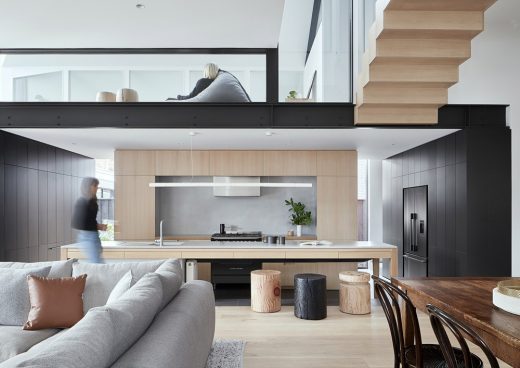
photograph : Shannon McGrath
Connect Six House
Richmond Apartment
Architects: tsai design
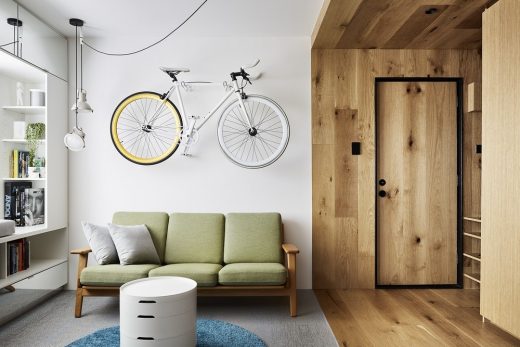
image courtesy of architects office
New Apartment in Richmond
Australian Unity
Design: Bates Smart Architects
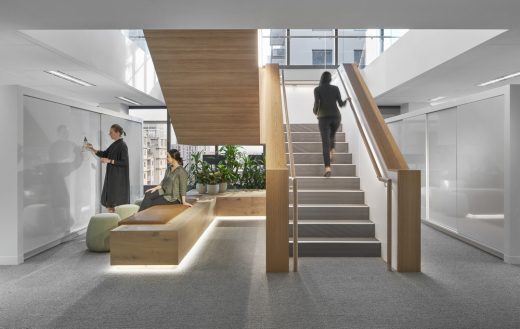
photo © Bates Smart
Australian Unity Melbourne Workplace
Abode318 Apartments
Design: Elenberg Fraser
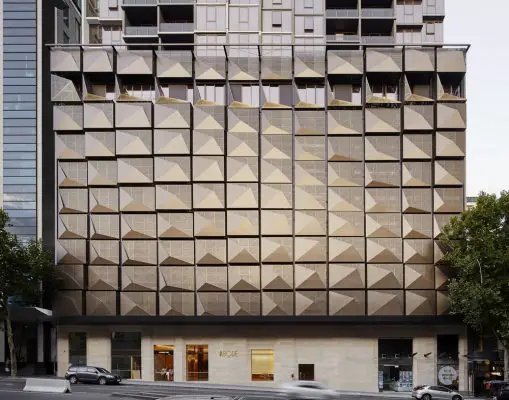
photo : Peter Clarke
Abode318 Apartments
Comments / photos for the Olinda House in Melbourne, Victoria – page welcome

